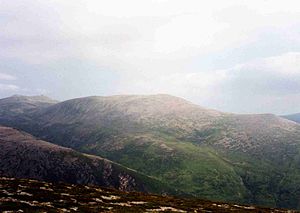Derry Cairngorm: Difference between revisions
Created page with '{{Infobox hill |name=Derry Cairngorm |gaelic=Càrn Gorm an Doire |county=Aberdeenshire |picture=Derry_Cairngorm_from_Carn_a_Mhaim.jpg |picture caption=Derry Cairngorm from Càrn …' |
|||
| Line 39: | Line 39: | ||
==References== | ==References== | ||
{{Commons | {{Commons}} | ||
{{reflist}} | {{reflist}} | ||
*Bennett, Donald et al.: ''The Munros'': Scottish Mountaineering Trust: ISBN 0-907521-13-4 | *Bennett, Donald et al.: ''The Munros'': Scottish Mountaineering Trust: ISBN 0-907521-13-4 | ||
| Line 46: | Line 46: | ||
*Butterfield, Irvine: ''The Magic Of The Munros'', ISBN 0-7153-2168-4 | *Butterfield, Irvine: ''The Magic Of The Munros'', ISBN 0-7153-2168-4 | ||
{{Munro}} | |||
Revision as of 00:27, 11 October 2013
| Derry Cairngorm | |||
| Aberdeenshire | |||
|---|---|---|---|
 Derry Cairngorm from Càrn a' Mhàim | |||
| Range: | Cairngorms | ||
| Summit: | 3,789 feet NJ044013 | ||
Derry Cairngorm is a mountain in Aberdeenshire in the Cairngorms range, 9 miles north west of Braemar.
The mountain's name is from the local Gaelic Càrn Gorm an Doire and means "Blue Cairn of Derry", while Derry in turn is the Gaelic doire or doireach, meaning "wooded", a reference to the Scots pines that adorn the southern slope of the mountain near Derry Lodge, remnants of the old Caledonian Forest.
With a height of 3,789 feet, Derry Cairngorm is the 21st highest mountain in Great Britain. It is regarded as part of the central group of Cairngorm hills, along with Ben Macdhui and Càrn a' Mhàim. Macdhui stands 2½ miles to the northwest and they are connected by a col with a height of 3,330 feet. The mountain was originally named An Carn Gorm but was renamed Carn Gorm an Doire to avoid confusion with the nearby Cairn Gorm, the name later anglicised to Derry Cairngorm.
The hill is well seen from Inverey and often appears as dark blue in colour, however from other angles it takes on a distinct pink tinge as result of its granite rocks (see photo).[1]
Geography
Derry Cairngorm is a five-mile-long ridge-type mountain that runs north to south, it rises from Glen Luibeg in the south and concludes at Coire Etchachan in the north, where it is joined to Beinn Mheadhoin. Coire Etchachan has Loch Etchachan lying within it, at a height of 3,050 feet; the highest notable expanse of water in Great Britain.[2] It has trout living in it.
On its eastern flanks, the mountain falls steeply and craggily into Glen Derry while its western flanks descend more moderately to the valley of the infant Luibeg Burn. Derry Cairngorm is characterised by large granite boulders on its higher slopes which make walking in the summit area difficult, the walker often having to resort to hopping between boulders. This large expanse of boulders is formed by the action of freezing and thawing in a periglacial environment and is known as a blockfield or felsenmeer.[3] All drainage from the mountain flows south by way of the Derry and Luibeg burns to join the River Dee, eventually reaching the sea at Aberdeen.
Derry Cairngorm has two subsidiary summits listed in the Munro Tables:
- Creagan a' Choire Etchachan (3,635 feet) stands a miles north of the main summit and is a fine viewpoint down into the wild Coire Etchachan.
- Sgurr an Lochan Uaine (3,225 feet), a mile northeast, is seen as just a hump near the cliff edge from the main summit but is more distinct when seen from Glen Derry, which it overlooks.
Nine hundred yards south of the summit lies an unnamed point with a height of 3,412 feet. This is the former "top" called Little Cairngorm, which was deleted from the tops' list in 1974.[4]
Ascents

Derry Cairngorm can be climbed from either the east or west sides of the Cairngorm range and either singly or in combination with other hills. The ascent from the east starts at the Linn of Dee car park (NO065901) and takes the track to Derry Lodge (a bicycle can used as far as the lodge). The southern ridge of Derry Cairngorm is then ascended to reach the summit, crossing Little Cairngorm on the way.
The mountain can also be climbed from the Cairn Gorm ski centre car park (NH989061) and involves climbing and crossing Ben Macdhui before continuing to Derry Cairngorm. The Ben Macdhui summit plateau can be a hazardous place in mist and bad weather.
The ascent from the Linn of Dee can also include climbing Càrn a' Mhàim and Ben Macdhui. This is a long hard day's walking of over 18 miles, although the use of a bicycle to and from Derry Lodge can help somewhat.
The view from the summit is very good with all the Cairngorm giants looking fine.[5]
References
| ("Wikimedia Commons" has material about Derry Cairngorm) |
- ↑ "The Magic of the Munros" Page 113 Gives information on translation.
- ↑ living.scotsman.com. Living Scotsman article referring to Loch Etchachan
- ↑ www.fettes.com. Gives details of Derry Cairngorm blockfield.
- ↑ Online version of Munros Table with details of subsidiary tops.
- ↑ "The Munros" Page 122 Gives details of ascents.
- Bennett, Donald et al.: The Munros: Scottish Mountaineering Trust: ISBN 0-907521-13-4
- Brown, Hamish: Hamish’s Mountain Walk, ISBN 1-898573-08-5
- Butterfield, Irvine: The High Mountains of Britain and Ireland, ISBN 0-906371-30-9
- Butterfield, Irvine: The Magic Of The Munros, ISBN 0-7153-2168-4
